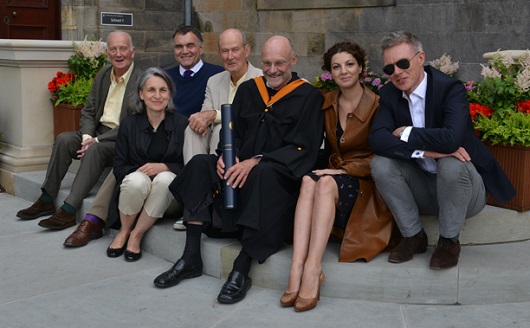Laureation address: Anselm Kiefer

Laureation by Dr Natalie Adamson
School of Art History
Chancellor, it is my privilege to present Mr Anselm Kiefer for the degree of Doctor of Letters, honoris causa.
Any exhibition catalogue will supply us with the artist’s biography: born 8 March 1945 in the Black Forest region of South-West Germany, Anselm Kiefer’s first solo exhibition took place in 1970 following studies in law and romance languages before art school. A decade later his reputation as an artist of international stature was confirmed when his work featured alongside that of his compatriot Georg Baselitz in the Federal Republic of Germany pavilion at the Venice Biennale. Frequent exhibitions at major museums of modern art took place throughout the 1980s and 90s. In 1993 Anselm Kiefer left Germany to settle in France, also travelling to India, China, Mexico and Australia. In 2007 he was commissioned to install a major work in the Louvre, Paris; the first contribution to its decor by a living artist since 1953. In 2010 Anselm Kiefer was named Professor for Artistic Creation at the Collège de France. A career survey, including new work, took place at the Royal Academy, London, in 2014.
Even such a brief sample of the facts produces a schematic timeline that tells us all too little about the work of an extraordinary artist. For Anselm Kiefer’s dedication to memory teaches us that time is not a smooth linear progression into the future: in his pictorial commemorations of the myths of German history and the triumphs of human civilisation time folds back upon itself. Time, like war or the workings of nature, is entropic and chaotic. It produces ruination, as the once monumental stone buildings of the Nationalist Socialist regime crumble and the wheat rots in the fields, surrounded by ancient forests. This is what Kiefer shows us in his monumental paintings, caked with paint so thick it becomes primeval mud. But like the blooms that come again each spring, as Kiefer declares in the title of his nine lectures for the Collège de France: art will survive its ruins.
Of course, dates do matter. Return to March 1945 when Kiefer was born amid the wreckage of war’s end. After Hitler and Nazism and their terrible effort to re-make the world as the Third Reich, how could one imagine being an artist? Moreover, a German artist? An early answer to this existential question was laced with bitter humour and radical, taboo-breaking imagery to pierce the amnesiac fog surrounding Germany’s not-so-distant past: a series of photographic collage works titled Occupations made in 1969 using self-portrait photographs of the artist dressed in a semblance of military uniform performing the Hitler salute. In subsequent large-scale paintings Kiefer took inspiration from Paul Celan’s famous poem of 1952, Death Fugue, to mourn the splitting of Germany and its people through the expunging of its Jewish population. His intimate dialogue with Celan and other poets underpins numerous works, where by inscribing names and phrases across the painted terrain, Kiefer melds text and image together in an epic reflection on mankind’s cultural efforts.
There is nothing nostalgic about Anselm Kiefer’s vision of the past, nor is his art practice in any way traditional. In his astonishing paintings – if they may be called that, for their surface is often three-dimensional, with protruding objects and containing straw, earth, clay, ash, blood, gold and flowers – what may seem to be detritus is chosen for its precise physical attributes and potential for symbolic meaning. Ropes of straw climbing the surface of one painting stand in for the golden hair of a beloved woman and, more literally, wheat fields. In another ruined landscape strewn with straw, a book made of lead is affixed to the surface. The heavy, malleable softness of lead is, in the artist’s words, a ‘material for ideas’; it contains something hidden that once inspired alchemists to extract gold from its grey molten substance. In the artist’s hands, lead is sculpted into towers of books or the shells of airplanes brought down to earth. Anselm Kiefer’s works combine multiple media and materials brutally melded together to become layered memorials to their own making.
In more than one early work appears a painter’s palette, suspended by rope or fluttering wings or balanced on a pole. It seems to signify the classical mission of the artist to give ideal form and substance to our myths and actions. This is no easy task given the absurdity of history. Anselm Kiefer reminds us that the arts should be difficult, difficult to make and difficult to comprehend. In Kiefer’s world, knowledge is hard-won. Out of chaos comes that dark light that falls from the stars, to cite the title of a deserted landscape painting of 1999.
In Anselm Kiefer’s work to date we discover an architect, engineer, philosopher, linguist, teacher, chemist, geologist, scribe, astronomer, alchemist, botanist, theologian, pilgrim, mystic, iconoclast, arsonist, archaeologist … and an artist who with astonishing skill, aesthetic seduction and compelling moral force, creates artworks that never retreat from their questioning mission.
Chancellor, in recognition of his outstanding contribution to the world of the arts, I invite you to confer on Mr Anselm Kiefer the degree of Doctor of Letters, honoris causa.
Category Awards